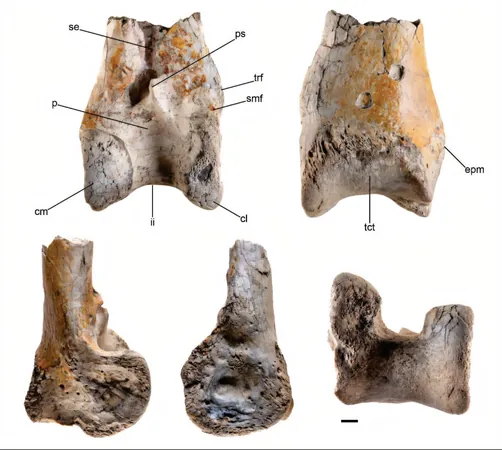
Discoveries from 12 Million Years Ago: The Giant Terror Bird of South America Revealed!
2024-11-04
Author: Jacques
Groundbreaking Study Unveils Insights on Terror Birds
In a groundbreaking study published in Palaeontology, a team of researchers including experts from Johns Hopkins University has unveiled critical insights into a colossal member of the extinct terror bird family. This revelation stems from the analysis of a fossilized leg bone discovered in Colombia's Tatacoa Desert, which could potentially be the largest example of its kind ever found.
Significance of the Fossil Discovery
Leading the research, terror bird specialist Federico J. Degrange and Siobhán Cooke, a prominent evolutionary biologist, have dated the fossil to the Miocene epoch, approximately 12 million years ago. The leg bone—a left tibiotarsus, which is akin to the human shin bone—was unearthed nearly two decades ago by curator Cesar Augusto Perdomo. However, it wasn’t until 2023 that its significance as a terror bird was acknowledged.
Size and Predatory Role of Terror Birds
This particular specimen, believed to be the northernmost evidence of terror birds in South America, suggests a formidable size, surpassing known phorusrhacids by 5% to 20%. Known terror birds varied from three to nine feet tall, but this discovery hints at even larger predators prowling the ancient landscapes.
Unique Features and Potential Threats
Cooke highlighted the leg bone's distinctive features, including unique deep pits characteristic of phorusrhacids and potential teeth marks from a massive extinct caiman called Purussaurus, which could reach lengths of up to 30 feet. 'Given the size of the crocodilians at that time, it’s likely the terror bird met its end due to its injuries,' she explained.
Distribution and Ecosystem Dynamics
Previously, the majority of terror bird fossils have been found in southern South America, primarily in provinces like Argentina and Uruguay. The discovery in Colombia indicates that these predators played a significant role in the predatory dynamics of ancient ecosystems in the region.
Ancient Colombian Environment
Ancient Colombia was likely a lush environment with winding rivers, supporting a diverse array of wildlife including primates, giant ground sloths, and car-sized glyptodonts. Today, the only surviving relative of these birds is the seriema, a three-foot-tall bird that roams the same lands.
Reflections on a Transformative Landscape
'This region reflected a rich ecosystem unlike what we observe today, especially before the connection between South and North America,' Cooke noted, emphasizing the transformative landscape of our planet over millions of years.
Implications for Future Discoveries
The fossil’s rarity suggests that terror birds might have been less common in this region during their existence, leaving scientists to ponder the potential for undiscovered fossils in existing collections that have yet to be correctly identified due to their less diagnostic appearance.
A Captivating Prehistoric Time
Envisioning an ancient habitat full of now-extinct wildlife, Cooke captures the allure of this prehistoric time, envisioning it as a captivating landscape bustling with extraordinary species.
Collaborative Efforts in Research
The study brought together contributions from multiple research facilities and universities, showcasing the collaborative effort to unravel the archaeological past of our planet. As the team continues to investigate, the mysterious world of ancient South America and its formidable creatures becomes increasingly illuminated.
Final Thoughts
Would you have wanted to stroll among these titanic beasts in their prime? The findings surely evoke wonder about the rich tapestry of life that once thrived on Earth!









 Brasil (PT)
Brasil (PT)
 Canada (EN)
Canada (EN)
 Chile (ES)
Chile (ES)
 España (ES)
España (ES)
 France (FR)
France (FR)
 Hong Kong (EN)
Hong Kong (EN)
 Italia (IT)
Italia (IT)
 日本 (JA)
日本 (JA)
 Magyarország (HU)
Magyarország (HU)
 Norge (NO)
Norge (NO)
 Polska (PL)
Polska (PL)
 Schweiz (DE)
Schweiz (DE)
 Singapore (EN)
Singapore (EN)
 Sverige (SV)
Sverige (SV)
 Suomi (FI)
Suomi (FI)
 Türkiye (TR)
Türkiye (TR)